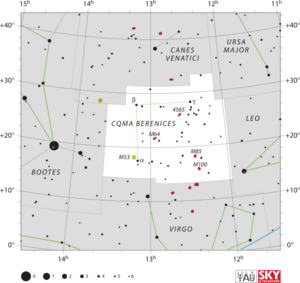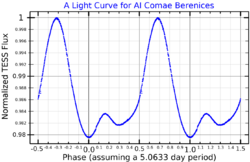Astronomy:17 Comae Berenices
| Observation data {{#ifeq:J2000.0|J2000.0 (ICRS)|Epoch J2000.0 Equinox J2000.0 (ICRS)| Epoch J2000.0 [[Astronomy:Equinox (celestial coordinates)|Equinox J2000.0}} | |
|---|---|
| Constellation | Coma Berenices |
| 17 Com A | |
| Right ascension | 12h 28m 54.703s[1] |
| Declination | +25° 54′ 46.27″[1] |
| Apparent magnitude (V) | 5.242±0.004[2] |
| 17 Com BC | |
| Right ascension | 12h 28m 44.565s[3] |
| Declination | +25° 53′ 57.56″[3] |
| Apparent magnitude (V) | 6.635[4] |
| Characteristics | |
| 17 Com A | |
| Spectral type | A0p[5] A0 SrCrEu[2] |
| B−V color index | −0.056±0.009[6] |
| Variable type | α2 CVn + δ Sct(?)[7] |
| 17 Com BC | |
| Spectral type | kA2hA9VmF0[8] |
| U−B color index | 0.084[4] |
| B−V color index | 0.216[4] |
| Astrometry | |
| 17 Com A | |
| Radial velocity (Rv) | −1.4±0.5[9] km/s |
| Proper motion (μ) | RA: −23.539[1] mas/yr Dec.: −15.620[1] mas/yr |
| Parallax (π) | 13.5382 ± 0.2245[1] mas |
| Distance | 241 ± 4 ly (74 ± 1 pc) |
| Absolute magnitude (MV) | 0.98[6] |
| 17 Com BC | |
| Radial velocity (Rv) | −1.8±0.1[10] km/s |
| Proper motion (μ) | RA: −22.296 mas/yr Dec.: −17.071 mas/yr |
| Parallax (π) | 13.6383 ± 0.0913[3] mas |
| Distance | 239 ± 2 ly (73.3 ± 0.5 pc) |
| Absolute magnitude (MV) | 2.46[6] |
| Orbit[11] | |
| Primary | 17 Com B |
| Companion | 17 Com C |
| Period (P) | 68.290±0.012 d |
| Eccentricity (e) | 0.296±0.008 |
| Periastron epoch (T) | 2,448,313.4±0.4 JD |
| Argument of periastron (ω) (secondary) | 260.7±2.2° |
| Semi-amplitude (K1) (primary) | 14.0±0.2 km/s |
| Details | |
| 17 Com A | |
| Mass | 2.38 M☉[2] 2.61 M☉[12] 2.75±0.3[13] M☉ |
| Radius | 2.09[5] R☉ |
| Luminosity | 42.7[5] L☉ |
| Surface gravity (log g) | 4.27 cgs[12] 3.70±0.20[13] cgs |
| Temperature | 10,212 K[5] 9,309±250[13] K |
| Rotational velocity (v sin i) | 20.4±0.4[5] km/s |
| Age | 101[12] Myr |
| 17 Com BC | |
| Mass | 1.74±0.6[14] M☉ |
| Surface gravity (log g) | 4.29±0.20[14] cgs |
| Temperature | 8,068±200[14] K |
| Rotational velocity (v sin i) | 22[4] km/s |
| Other designations | |
| 17 Com A: AI Com, BD+26°2354, GC 17012, HD 108662, HIP 60904, HR 4752, SAO 82330[15] | |
| 17 Com B: BD+26°2353, GC 17007, HD 108651, HIP 60891, HR 4751, SAO 82328[16] | |
| Database references | |
| 17 Com A | |
| SIMBAD | data |
| 17 Com B | |
| SIMBAD | data |
17 Comae Berenices (17 Com) is a multiple star system in the northern constellation of Coma Berenices. The brighter component, 17 Com A, is a naked eye star with an apparent visual magnitude of 5.2.[2] It has a faint companion of magnitude 6.6,[6] 17 Com B, positioned at an angular separation of 146.4″ along a position angle of 251°, as of 2018.[17] They are located at a distance of approximately 240 light years from the Sun based on parallax measurements.[1]
The double nature of this system was documented by F. G. W. Struve in 1836.[17] The pair share a common proper motion through space[13] and thus may be associated. Component B is itself a binary star system, although only the brighter component is visible in the spectrum.[11] The Washington Double Star Catalogue lists the companion as component C, with a magnitude of 13.7 and a separation of 1.4″.[17] 17 Com has been recognized as members of the Coma Star Cluster,[18] but this is disputed.[19]
The star 17 Com A was classified as chemically peculiar by A. J. Cannon prior to 1918.[20] W. W. Morgan in 1932 found the star's spectral lines varied in strength and appearance,[21] and detected lines of the element europium.[22] H. W. Babcock and T. G. Cowling measured the Zeeman effect in this star, demonstrating in 1953 that it has a magnetic field.[23] In 1967, E. P. J. van den Heuvel noted the blue excess of this star, suggesting it is a blue straggler.[24] G. W. Preston and associates in 1969 found that the luminosity and magnetic field of this star varied in strength with a time scale of around five days.[25]
17 Com A is a magnetic chemically peculiar Ap star with a stellar classification of A0p[5] or A0 SrCrEu,[2] with the latter indicating the spectrum shows abundance anomalies of the elements strontium, chromium, and europium. The level of silicon in the atmosphere is also enhanced[27] and it shows a significant helium deficiency.[5] It has the variable star designation of AI Com, and is classified as an Alpha2 Canum Venaticorum variable and a suspected Delta Scuti variable.[7] It has been identified as a suspected blue straggler.[13]
The primary has an estimated age of 101[12] million years and is spinning with a projected rotational velocity of 20 km/s.[5] It has more than double the mass and twice the radius of the Sun.[2][5] The magnetic field strength is 3,300±150 G.[5] It is radiating 43[5] times the luminosity of the Sun from its photosphere at an effective temperature of around 10,000 K.[5][13]
The co-moving companion, component B, is a single-lined spectroscopic binary with an orbital period of 68.3 days and an eccentricity (ovalness) of 0.3.[11] The visible member of this binary pair is a strong Am star[4] with a class of kA2hA9VmF0,[8] indicating it has the Calcium K-lines of an A0 star, the hydrogen lines of an A9 star, and the metallic lines of an F0 star.[28]
References
- ↑ 1.0 1.1 1.2 1.3 1.4 Brown, A. G. A. (2021). "Gaia Early Data Release 3: Summary of the contents and survey properties". Astronomy & Astrophysics 649: A1. doi:10.1051/0004-6361/202039657. Bibcode: 2021A&A...649A...1G. Gaia EDR3 record for this source at VizieR.
- ↑ 2.0 2.1 2.2 2.3 2.4 2.5 Paunzen, E. et al. (July 2021), "Magnetic chemically peculiar stars investigated by the Solar Mass Ejection Imager", Monthly Notices of the Royal Astronomical Society 504 (3): 3758–3772, doi:10.1093/mnras/stab1100, Bibcode: 2021MNRAS.504.3758P.
- ↑ 3.0 3.1 3.2 Brown, A. G. A. (2021). "Gaia Early Data Release 3: Summary of the contents and survey properties". Astronomy & Astrophysics 649: A1. doi:10.1051/0004-6361/202039657. Bibcode: 2021A&A...649A...1G. Gaia EDR3 record for this source at VizieR.
- ↑ 4.0 4.1 4.2 4.3 4.4 Iliev, I. Kh. et al. (August 2006), "Abundance analysis of Am binaries and search for tidally driven abundance anomalies - II. HD861, HD18778, HD20320, HD29479, HD96528 and HD108651", Monthly Notices of the Royal Astronomical Society 370 (2): 819–827, doi:10.1111/j.1365-2966.2006.10513.x, Bibcode: 2006MNRAS.370..819I.
- ↑ 5.00 5.01 5.02 5.03 5.04 5.05 5.06 5.07 5.08 5.09 5.10 5.11 Romanovskaya, A. M. et al. (September 2020), "Fundamental parameters of Ap-star HD 108662", INASAN Science Reports 5 (4): 219–223, doi:10.26087/INASAN.2020.5.4.010, Bibcode: 2020INASR...5..219R.
- ↑ 6.0 6.1 6.2 6.3 Anderson, E.; Francis, Ch. (2012), "XHIP: An extended hipparcos compilation", Astronomy Letters 38 (5): 331, doi:10.1134/S1063773712050015, Bibcode: 2012AstL...38..331A.
- ↑ 7.0 7.1 Samus, N. N. et al. (2017), "General Catalogue of Variable Stars", Astronomy Reports, 5.1 61 (1): 80–88, doi:10.1134/S1063772917010085, Bibcode: 2017ARep...61...80S.
- ↑ 8.0 8.1 Abt, H. A.; Cardona, O. (1984), "The nature of the visual companions of AP and AM stars", The Astrophysical Journal 276: 266, doi:10.1086/161610, Bibcode: 1984ApJ...276..266A.
- ↑ Gontcharov, G. A. (November 2006), "Pulkovo Compilation of Radial Velocities for 35495 Hipparcos stars in a common system", Astronomy Letters 32 (11): 759–771, doi:10.1134/S1063773706110065, Bibcode: 2006AstL...32..759G.
- ↑ de Bruijne, J. H. J.; Eilers, A.-C. (October 2012), "Radial velocities for the HIPPARCOS-Gaia Hundred-Thousand-Proper-Motion project", Astronomy & Astrophysics 546: 14, doi:10.1051/0004-6361/201219219, A61, Bibcode: 2012A&A...546A..61D.
- ↑ 11.0 11.1 11.2 Abt, Helmut A.; Willmarth, Daryl W. (August 1999), "Binaries in the Praesepe and Coma Star Clusters and Their Implications for Binary Evolution", The Astrophysical Journal 521 (2): 682–690, doi:10.1086/307569, Bibcode: 1999ApJ...521..682A.
- ↑ 12.0 12.1 12.2 12.3 David, Trevor J.; Hillenbrand, Lynne A. (2015), "The Ages of Early-Type Stars: Strömgren Photometric Methods Calibrated, Validated, Tested, and Applied to Hosts and Prospective Hosts of Directly Imaged Exoplanets", The Astrophysical Journal 804 (2): 146, doi:10.1088/0004-637X/804/2/146, Bibcode: 2015ApJ...804..146D.
- ↑ 13.0 13.1 13.2 13.3 13.4 13.5 Monier, Richard; Deal, Morgan (July 2020), "The Evolutionary Status of 17 Com, The Hottest Member of Coma Berenices", Research Notes of the AAS 4 (7): 104, doi:10.3847/2515-5172/aba35a, 104, Bibcode: 2020RNAAS...4..104M.
- ↑ 14.0 14.1 14.2 Deal, Morgan; Monier, Richard (August 2020), "The Surface Abundances of 17 Com B: A Test for Self-consistent Evolutionary Models", Research Notes of the AAS 4 (8): 144, doi:10.3847/2515-5172/abb01f, 144, Bibcode: 2020RNAAS...4..144D.
- ↑ 15.0 15.1 "HD 108662". SIMBAD. Centre de données astronomiques de Strasbourg. http://simbad.u-strasbg.fr/simbad/sim-basic?Ident=HD+108662.
- ↑ 16.0 16.1 "HD 108651". SIMBAD. Centre de données astronomiques de Strasbourg. http://simbad.u-strasbg.fr/simbad/sim-basic?Ident=HD+108651.
- ↑ 17.0 17.1 17.2 Mason, B. D. et al. (2014), "The Washington Visual Double Star Catalog", The Astronomical Journal 122 (6): 3466–3471, doi:10.1086/323920, Bibcode: 2001AJ....122.3466M.
- ↑ Casewell, S. L. et al. (January 2006), "New stellar members of the Coma Berenices open star cluster", Monthly Notices of the Royal Astronomical Society 365 (2): 447–453, doi:10.1111/j.1365-2966.2005.09689.x, Bibcode: 2006MNRAS.365..447C.
- ↑ Silaj, J.; Landstreet, J. D. (June 2014), "Accurate age determinations of several nearby open clusters containing magnetic Ap stars", Astronomy & Astrophysics 566: 18, doi:10.1051/0004-6361/201321468, A132, Bibcode: 2014A&A...566A.132S.
- ↑ Perrine, C. D. (June 1918), "On the cause underlying the spectral differences of the stars", Astrophysical Journal 47: 289–323, doi:10.1086/142406, Bibcode: 1918ApJ....47..289P.
- ↑ Morgan, W. W. (September 1932), "A Study of the Composite Spectrum of the A-Type Star 14 Comae", Astrophysical Journal 76: 144, doi:10.1086/143410, Bibcode: 1932ApJ....76..144M.
- ↑ Morgan, W. W. (January 1932), "Studies in Peculiar Stellar Spectra. III. on the Occurrence of Europium in A-Type Stars", Astrophysical Journal 75: 46, doi:10.1086/143354, Bibcode: 1932ApJ....75...46M.
- ↑ Babcock, H. W.; Cowling, T. G. (1953), "General magnetic fields in the Sun and stars (Report on progress of astronomy)", Monthly Notices of the Royal Astronomical Society 113: 357–381, doi:10.1093/mnras/113.3.357, Bibcode: 1953MNRAS.113..357B.
- ↑ van den Heuvel, E. P. J. (April 1967), "The origin of blue stragglers and peculiar and metallic-line stars", The Observatory 87: 68–72, Bibcode: 1967Obs....87...68V.
- ↑ Preston, G. W. et al. (May 1969), "The magnetic field and light variations of 17 COM and kap Cnc", Astrophysical Journal 156: 653, doi:10.1086/149995, Bibcode: 1969ApJ...156..653P.
- ↑ "MAST: Barbara A. Mikulski Archive for Space Telescopes". Space Telescope Science Institute. https://mast.stsci.edu/portal/Mashup/Clients/Mast/Portal.html.
- ↑ Savanov, I. S. et al. (November 1996), "A study of the atmospheres of the SrCrEu stars 17 Com A and 21 Com in the Coma Cluster", Astronomy Letters 22 (6): 815–821, Bibcode: 1996AstL...22..815S.
- ↑ Gray, Richard O.; Corbally, J. (2009), Stellar Spectral Classification, Princeton University Press, pp. 176–183, ISBN 978-0691125114
External links
- Kaler, James B. (July 25, 2014), "17 Comae Berenices", Stars, http://stars.astro.illinois.edu/sow/17com.html, retrieved 2022-01-17
 |



